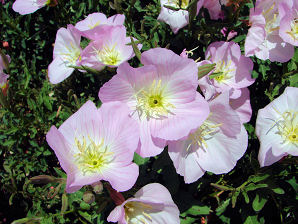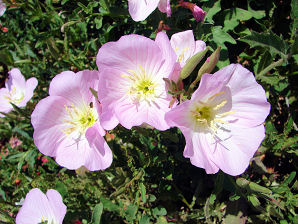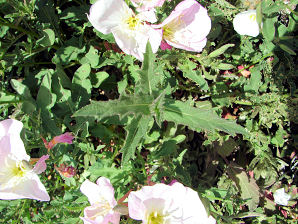Xeriscape Landscaping Plants For The Arizona Desert Environment.
Pictures, Photos, Information, Descriptions,
Images, & Reviews.
Groundcovers.
Mexican Evening Primrose, Oenothera speciosa.
We Are Proud Of Our SafeSurf Rating!
Click On Any Of The Following Links By Amazon.Com
For Books, & Videos About Wildflowers Of Arizona & The Southwest USA. No Obligation!
 |
| Mexican Evening Primrose, Oenothera speciosa. Photo Taken At Sun City, Arizona. |
|---|
 |  |
| Mexican Evening Primrose. Oenothera speciosa. | Mexican Evening Primrose. Oenothera speciosa. |
|---|---|
 | |
| Mexican Evening Primrose. Oenothera speciosa. | Mexican Evening Primrose. Oenothera speciosa. |
 /
/

Mexican Evening Primrose.
We wish to thank Wikipedia, the free encyclopedia for some of the information on this page. We share images and information with Wikipedia. This Primrose usually blooms in March to April in Arizona. If given water, it can become invasive. All parts are poisonous. About a third of the people who plant it, later on, want to remove it. It's alternate leaves are up to 2-3" long and �" across. They are lanceolate, elliptic, or oblanceolate in shape, while their margins are smooth (entire), dentate, or shallowly pinnatifid. A few leaves may have paired basal lobes. The leaves will either be sessile against their stems or they have petioles up to about 1 inch in length. Both the upper and lower leaf surfaces will be light to medium green, and be either glabrous or sparsely appressed-pubescent. About 1 - 3 flowers develop from the axils of the upper leaves. These appressed-pubescent flower buds are long and spindle-shaped. The flowers open during the daytime, and they will be about 2 - 3�" across. The flower has 4 broad petals, & 8 stamens with either white or yellow anthers. They will have a long white stigma that is 4 - clefted at the tip. These flowers are usually pinkish white; & they have fine pink lines that radiate outward from their throats across the wrinkled petals. The throats of these flowers are usually yellow. The flowers attract bees, moths, and hummingbirds.
Quick Notes:
Height: Up To 10 inches tall, and up to about 2 - 3 feet in diameter.
Flowers: Flowers Pinkish. about 2 - 3�" across. 4 broad petals, 8 stamens with white or yellow anthers.
Flowers: Up to about 8 inch stems.
Flowering Time: April - September.
Leaves: Leaves are in a basal rosette. Green, fuzzy leaves. alternate leaves are up to 2-3" long and �" across. They are lanceolate, elliptic, or oblanceolate in shape, while their margins are smooth (entire), dentate, or shallowly pinnatifid.
Found: Native to the rocky prairies and savannas of the lower Midwestern USA. The USDA claims it is native of the USA (AL, AR, AZ, CA, CT, FL, GA, IA, IL, IN, KS, KY, LA, MO, MS, NC, NE, NM, OH, OK, PA, SC, TN, TX, UT, VA, WV).
Hardiness:
Soil pH requirements:
Sun Exposure:
Elevation: 1,200 to 7,500 feet In Arizona.
Habitat: Arizona roadsides, ponderosa forest clearings, dry, rocky slopes; disturbed ground.
Miscellaneous: Photos Taken; March 19, 2008. Glendale, Arizona. An ideal xeriscape landscape plant at low elevations in Arizona.
|
We Are Proud Of Our SafeSurf Rating!



We Are Proud Of Our SafeSurf Rating!
Click On Any Of The Following Links By Amazon.Com
For Books, & Videos About Xerioscape Plants Of Arizona & The Southwest USA. No Obligation!
Back To Arizona Xeriscape Landscaping Main Page.
Back To Xeriscape Groundcovers Page Three.
Back To Arizona Wild Flowers Home Page
Back To DeLange Home Page
© 1966 - Present, Audrey, Eve, & George DeLange
| © 1966 - Present, Audrey, Eve, & George DeLange |


